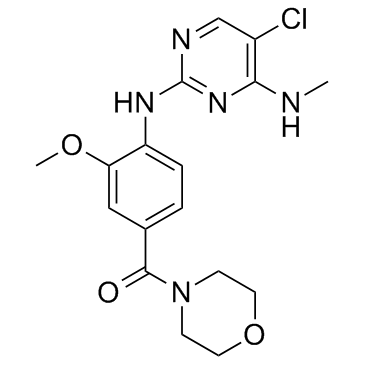HG-10-102-01 (LRRK2 inhibitor 1) is a novel, potent and selective inhibitor of wild-type LRRK2 (leucine-rich repeat kinase 2) with an IC50 of 23.3 nM. It is also an inhibitor of the G2019S mutant form LRRK2 with an IC50 of 3.2 nM. HG-10-102-01 maintains the ability to potently inhibit the biochemical activity of wild-type and G2019S mutant LRRK2. HG-10-102-01 substantially inhibits Ser910 and Ser935 phosphorylation of both wild-type LRRK2 and G2019S mutant at a concentration of 0.1-0.3 µM in cells and is the first compound reported to be capable of inhibiting Ser910 and Ser935 phosphorylation in mouse brain following intraperitoneal delivery of doses as low as 50 mg/kg.
Physicochemical Properties
| Molecular Formula | C17H20CLN5O3 |
| Molecular Weight | 377.8254 |
| Exact Mass | 377.125 |
| CAS # | 1351758-81-0 |
| PubChem CID | 58539301 |
| Appearance | White to off-white solid powder |
| Density | 1.4±0.1 g/cm3 |
| Boiling Point | 641.1±65.0 °C at 760 mmHg |
| Flash Point | 341.5±34.3 °C |
| Vapour Pressure | 0.0±1.9 mmHg at 25°C |
| Index of Refraction | 1.652 |
| LogP | 0.46 |
| Hydrogen Bond Donor Count | 2 |
| Hydrogen Bond Acceptor Count | 7 |
| Rotatable Bond Count | 5 |
| Heavy Atom Count | 26 |
| Complexity | 466 |
| Defined Atom Stereocenter Count | 0 |
| InChi Key | YEVOZZZLKJKCCD-UHFFFAOYSA-N |
| InChi Code | InChI=1S/C17H20ClN5O3/c1-19-15-12(18)10-20-17(22-15)21-13-4-3-11(9-14(13)25-2)16(24)23-5-7-26-8-6-23/h3-4,9-10H,5-8H2,1-2H3,(H2,19,20,21,22) |
| Chemical Name | [4-[[5-chloro-4-(methylamino)pyrimidin-2-yl]amino]-3-methoxyphenyl]-morpholin-4-ylmethanone |
| HS Tariff Code | 2934.99.9001 |
| Storage |
Powder-20°C 3 years 4°C 2 years In solvent -80°C 6 months -20°C 1 month |
| Shipping Condition | Room temperature (This product is stable at ambient temperature for a few days during ordinary shipping and time spent in Customs) |
Biological Activity
| ln Vitro | The G2019S mutant and wild-type LRRK2 have their Ser910 and Ser935 phosphorylation substantially inhibited by HG-10-102-01 (0-3 μM, 90 minutes) [1]. |
| ln Vivo | In mouse kidney, spleen, and brain, HG-10-102-01 (0-100 mg/kg, IP, once) exhibits inhibitory effects on LRRK2 Ser910/Ser935 phosphorylation [1]. With a short half-life of 0.13 h, minimal plasma exposure, and good oral bioavailability (%F = 67), HG-10-102-01 (1 mg/kg IV; 10 mg/kg PO; once) was shown [1]. |
| Cell Assay |
Western Blot Analysis[1] Cell Types: HEK293 cells, Mouse Swiss 3T3 cells and mouse embryonic fibroblasts Tested Concentrations: 0, 0.01, 0.03, 0.1, 0.3, 1 and 3 μM Incubation Duration: 90 minutes Experimental Results: Induction dose dependent Inhibits Ser910 and Ser935 phosphorylation in wild-type LRRK2 and LRRK2[G2019S] stably transfected into HEK293 cells. Endogenous LRRK2 induces similar dose-dependent Ser910 and Ser935 dephosphorylation in mouse Swiss 3T3 cells and mouse embryonic fibroblasts. |
| Animal Protocol |
Animal/Disease Models: wild-type male C57BL/6 mice [1] Doses: 0, 3, 10, 30, 50 and 100 mg/kg Route of Administration: IP, once Experimental Results: Ser910 and Ser935 of LRRK2 in all tissues were almost completely eliminated Phosphorylation has inhibitory effects on the brain at doses of 100 mg/kg and 50 mg/kg, but only partially inhibits the brain at doses of 30 mg/kg and 10 mg/kg. Animal/Disease Models: wild-type male C57BL/6 mice [1] Doses: 1 mg/kg (IV); 10 mg/kg (PO) Route of Administration: IV, PO; once (pharmacokinetic/PK/PK analysis) Experimental Results: HG- pharmacokinetic/PK/PK parameters of 10-102-01 in male C57BL/6 mice [1]. IV (1 mg/kg) PO (10 mg/kg) Tmax (h) 0.25 Cmax (ng/mL) 1330 1241 AUClast (ng/mL*h) 74.85 502.34 AUCINF (ng/mL*h) 75.06 503.41 T1/2 (h) 0.13 CL (mL/min/kg) 222.04 Vss (L/kg) 1.68 F (%) 67 |
| References |
[1]. Brain Penetrant LRRK2 Inhibitor. ACS Med Chem Lett. 2012 Aug 9;3(8):658-662. [2]. Synthesis of [11C]HG-10-102-01 as a new potential PET agent for imaging of LRRK2 enzyme in Parkinson's disease. Bioorg Med Chem Lett. 2017 Mar 15;27(6):1351-1355. |
| Additional Infomation | HG-10-102-01 is a monocarboxylic acid amide resulting from the formal condensation of the carboxy group of 4-{[5-chloro-4-(methylamino)pyrimidin-2-yl]amino}-3-methoxybenzoic acid with the amino group of morpholine. It is an inhibitor of leucine-rich repeat kinase 2 (LRRK2). It has a role as an EC 2.7.11.1 (non-specific serine/threonine protein kinase) inhibitor. It is an aminopyrimidine, a member of morpholines, a monocarboxylic acid amide, an organochlorine compound, a secondary amino compound and an aromatic ether. |
Solubility Data
| Solubility (In Vitro) | DMSO : ≥ 50 mg/mL (~132.33 mM) |
| Solubility (In Vivo) |
Solubility in Formulation 1: ≥ 2 mg/mL (5.29 mM) (saturation unknown) in 10% DMSO + 40% PEG300 + 5% Tween80 + 45% Saline (add these co-solvents sequentially from left to right, and one by one), clear solution. For example, if 1 mL of working solution is to be prepared, you can add 100 μL of 20.0 mg/mL clear DMSO stock solution to 400 μL PEG300 and mix evenly; then add 50 μL Tween-80 to the above solution and mix evenly; then add 450 μL normal saline to adjust the volume to 1 mL. Preparation of saline: Dissolve 0.9 g of sodium chloride in 100 mL ddH₂ O to obtain a clear solution. Solubility in Formulation 2: ≥ 2 mg/mL (5.29 mM) (saturation unknown) in 10% DMSO + 90% (20% SBE-β-CD in Saline) (add these co-solvents sequentially from left to right, and one by one), clear solution. For example, if 1 mL of working solution is to be prepared, you can add 100 μL of 20.0 mg/mL clear DMSO stock solution to 900 μL of 20% SBE-β-CD physiological saline solution and mix evenly. Preparation of 20% SBE-β-CD in Saline (4°C,1 week): Dissolve 2 g SBE-β-CD in 10 mL saline to obtain a clear solution. (Please use freshly prepared in vivo formulations for optimal results.) |
| Preparing Stock Solutions | 1 mg | 5 mg | 10 mg | |
| 1 mM | 2.6467 mL | 13.2335 mL | 26.4669 mL | |
| 5 mM | 0.5293 mL | 2.6467 mL | 5.2934 mL | |
| 10 mM | 0.2647 mL | 1.3233 mL | 2.6467 mL |
